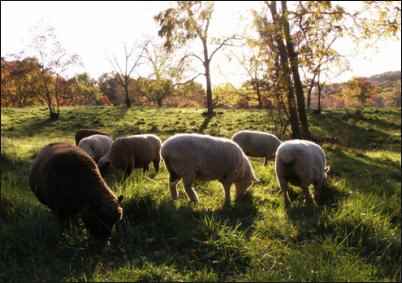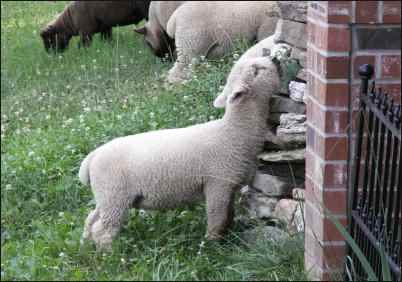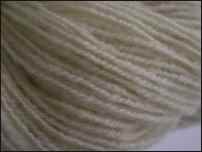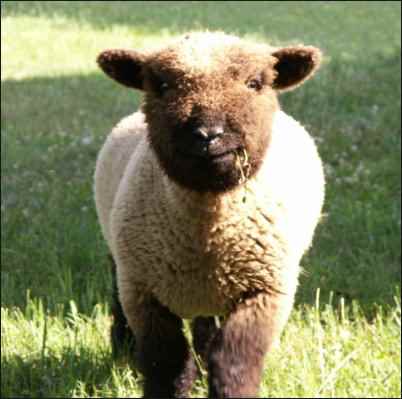Babydoll Southdown sheep cause many people to exclaim, “Awww!” on the first encounter. They are known for their teddy-bear looks and sweet smile… an appearance stuffed-toy designers strive for. Yet these little sheep are the real thing and come by their cuddly looks naturally!

Adding to their adorableness, they enjoy interacting with Their Person if encouraged. Not that they are easy though! Being a prey animal, they are naturally leery around new people and situations; but given time and effort, the relationship often develops to a level that can surprise a person. “Who would have thought I’d like my sheep this much?” But this endearing quality of the Babydoll Southdowns is why today most have very different lives than their more distant ancestors.
These small sheep are the direct descendants of the original Southdowns, not the “improved, super-sized” American Southdowns that are more common today. These sheep originated in the South Downs of Sussex County, England. They are generally credited with being one of the oldest breeds of sheep, and are the oldest of the Down breeds. In some of the earliest writings, they were attributed with having a relatively good fleece of fine, high-priced wool, hindquarters heavier than the front (providing flavorful meat), and they were able to thrive on low-nutrient heathland.
John Ellman began to standardize the breed in 1780, and developed his flock into one that caught the attention of sheepmen throughout the country. The Southdowns were soon infused into every meat breed in Britain, and contributed to the foundation stock of other down breeds: Suffolk, Hampshire, and Oxford. Importation of the small, chunky sheep from Ellman’s flock into America happened from 1824 to 1829. They grew in popularity in both England and America, and by 1908 there were approximately 367 registered flocks totaling about 111,000 ewes.

After World War I, there was a major shift. Demand for larger cuts of meat, electric freezers, and a movement away from the self-sustaining family farm no longer favored their meat. Merino sheep had been imported and, due to their ultra-fine wool, became the favorite among wool-producers. The original little Southdowns were almost forgotten. After some time, the public came to view the Southdown breed as the larger, leggier Southdowns that had been developed in New Zealand and were now being imported.
Around 1990, Robert Mock began a search for the remaining original Southdowns after reading articles about them. He eventually located two small flocks, and after some promotion of them, was able to find others. He formed a registry and labeled the small sheep “Olde English Babydoll Southdowns” to differentiate them from the larger modern Southdowns. Numbers grew, and today there are two registries with many happy owners of these delightful little sheep.
Babydoll Southdown sheep stand only 17” to 24” at the shoulder. Their short height makes them very useful for mowing, trimming, and pruning in vineyards and orchards. Most Babydolls do not stand on their back legs to reach the higher vegetation, especially after they mature. When they have been grazing a vineyard, it is easy to see the exact height they reach since the vegetation will be pruned below an imaginary straight horizontal line. Since they also mow under the vines, they are perfect for organic weed control, fertilizing as they go! Even during rainy weather, their tiny hooves do not tear up and compact the soil as machinery would.

Some considerations when using them in a vineyard are the height of the wire where the grapes hang since the fruit should be out of their reach, and also the types of sprays used on the vegetation. Most organic grape growers use copper sprays and they can be a hazard. Copper accumulates over time in the sheep’s body and can be toxic. That is why mineral supplements and feeds are formulated differently for sheep than for other livestock with copper being kept to very low levels. On all sprays used, it is important to keep them out of the area for the length of both the “preharvest interval” as well as the “reentry interval”, since the sheep will be breathing the air, brushing against the plants, and also consuming the vegetation. Risks to the sheep are associated birth defects, but of course, there are other health complications that could possibly arise. Based on this, an alternative way to feed them (penned and feeding hay, or letting them graze a different pasture) is necessary during and after spraying. Make sure it is a place to where spray cannot drift. Another consideration for orchards and vineyards is that Babydolls will readily eat young vines and branches, so the sheep should only be introduced to established trees or vines. Since they love tender foliage, it is best to keep them out in the early spring when new vegetation is forming. Planning and managing of the sheep in a vineyard or orchard is very necessary if you want many years of labor from healthy woolly workers, as well as a good harvest!

Some people think Babydolls are an adorable, green alternative to a lawnmower. They are, and they also trim edges very well! For many years, we’ve mowed our lawn only once or twice a year to knock down the remaining weeds—typically, poisonous ones—that the sheep refuse to eat. We also do this with their pastures. This keeps those plants from going to seed and taking over. Babydolls love most weeds, including dandelions and even poison ivy! However, they also love roses and many ornamental bushes and flowers. I put ornamental fencing around the areas where I want my flower beds, and let the sheep take care of lawn care everywhere else. It seems to be a good compromise for both the sheep and for us. I do have to chuckle when the front porch is full of sheep hanging out, relaxing, and chewing their cuds!
In all grazing situations, keeping the Babydoll Southdown sheep safe from predators is very important. They are ideal prey and quite defenseless. If you have a good livestock guardian dog, you can get by with less secure fencing during the day, but more protection at night is still a good idea. Many people put their little sheep into a very secure pen each night. Babydolls tend to stay in a flock and are not prone to wandering far away, so the fencing chosen should be designed more to keep out predators than to contain sheep. On our farm, we have electric fencing around the perimeter, with many pastures inside. We also have several Great Pyrenees dogs that live with the flock. So far, we haven’t lost a single sheep to predators.
Most of the income from my flock comes through lamb sales, but none are sold for meat. My lambs go to people wanting them as cute lawn mowers, vineyard and orchard pruners, fiber producers, or barnyard pets. Many of my customers are families with young children, or older persons wanting more manageable animals. I remind them that although these sheep are short, they are quite muscular and strong. To make their routine care easier, it is best to treat them as pets and handle them frequently. It is also important to never separate one from the others, since being singled out is one of the most stressful things that can happen to a Babydoll. When I work with my flock, I’ve found putting them in a tight enclosed area and getting inside to work them one by one, causes the least amount of stress for them (and therefore, me). The quarters are cramped, and in true Babydoll fashion, I always have plenty of “inspectors” helping me. The ones with their noses in the way are almost always the ones I’ve already worked. Somehow they are all very aware of who is done and who is left!
Getting to know how the sheep think is very helpful in handling a flock. They taught me fairly early that it was better to have them work with, rather than against me! For instance, if I were to aggressively try to drive them somewhere, they would split off and circle back behind me. The more pressure I’d place on them, the worse the situation would get. So instead, I teach them to come running and follow me wherever I lead. This is something they learn quickly because I always provide a treat when I call them… like grain or to graze a different area. This makes it very easy to move them out of a large pasture even if I’m working alone.
One day I realized that I might need to drive them someday, but they were so used to always coming to me, I knew it wouldn’t work. So we started teaching that holding our arms out and wiggling our fingers meant to turn and go the other way. At first, I’d call and my daughter would “drive”. Then we switched roles since the sheep were used to always coming to me and moving away from her. Now either of us can lead or drive, and all stay calm. Of course, there are always a few who like to dawdle, but overall it goes well. Since Babydoll Southdown sheep have great flocking instincts, managing just a few key sheep will result in managing the rest of the flock too. Breaking things down into smaller steps and making it a routine makes managing sheep so much easier. You will be amazed at how smart they are, and how fast they are able to learn! Of course, this can also lead to a lot of frustration for a person who doesn’t understand how they think and doesn’t have a relationship built with them. I always have to smile when someone refers to sheep as being stupid because to me that simply means they haven’t spent enough time around Babydolls yet.
Trust is everything. It is built slowly, and they typically build it with people on a person-by-person basis, knowing each one. When a stranger comes, all the sheep watch every move made. I often tell my customers that they will know when they are gaining their sheep’s trust, because the sheep will spend time facing away, without an eye in view. Sheep have great peripheral vision which makes it difficult to actually sneak up on one. When a person is not trusted all the sheep may appear to be lost in grazing but most will have an eye the person can see. For me, trust makes lambing season go so much easier! A ewe will naturally be hyper-vigilant about her lambs. I want to be able to help her during labor and delivery, and also make sure she has milk available. Handling her lambs will be necessary, perhaps to help clear an airway, clip the umbilical cord, and maybe assist the lamb to nurse the first time. If the ewe is racing around, wide-eyed, fearfully stomping at me… well, you can imagine how well things go. I want even a first-time nervous mother to relax due to my presence and voice. If trust has been built, that happens.

Most of my customers for lambs find me through my website: MyLittleSheep.com. In my opinion, a website is the best way to connect with potential customers. It gives them a chance to learn more and “get to know my flock” before making contact with me. The website was originally started to simply share the things I learned. When I got my first flock, I knew so little about sheep and there was not much information online, so I vowed to share as I learned, hopefully making it easier for others. I have found one surprising aspect of having a website is the many requests from people wanting to visit the sheep. Several have told me they were planning their whole vacation route to include a visit! If you enjoy lots of visitors, a website can definitely encourage that. But if your lifestyle is by choice a quieter one, you’ll find yourself needing to disappoint people in order to maintain it. Now I limit my “sheep visitors” to those picking up their lambs… still quite a few since the lambs are usually sold two or three to a person.
Another way my flock earns their own keep is through the sale of their wool. Babydoll Southdown sheep are shorn once a year in the early spring. Their fiber is quite unique. It is rather fine, soft, very elastic, yet it doesn’t felt easily. This makes it a great choice for socks. At one time, Southdown wool was well-known and used in a lot of garments, but today it is rare. Even hand spinners are just beginning to learn about its properties and take notice of it again. Working with the wool from my flock has become a grand adventure of its own, opening up a whole other world… spinning, dyeing, weaving, knitting, and crocheting. It has been a very fun journey so far, with no end in sight! There are online sites for handmade products, such as Etsy.com. This is my shop there.

When I retain a lamb for my own flock, fleece quality is one of the most important factors as I choose. It has been so exciting for me to see the tangible results of those choices: each year having higher quality roving (wool prepared for spinning) come back from the mill than the year before. Sometimes I wonder if this is how John Ellman felt as he watched the improvements in his flock?
The final way my sheep contribute is through their pictures. There are online sites that allow a person to upload photographs so they can be sold on various items. When a sale happens, the photographer receives a commission. Since I love any excuse to take more pictures of these very photogenic cuties, this has been purely fun for me! However, there is one downside of establishing trust with the flock… they no longer face me when I come with a camera. Instead, they choose to ignore me. So now the easy photographs are of them grazing with their heads down, or just their rear ends! I find myself doing increasingly crazy things just to get them to look up, and then hoping no people saw me. My two online sites for photographs are www.cafepress.com/mylittlesheep and www.zazzle.com/mylittlesheep. Both offer similar items such as calendars for sale, but also others that are unique to each site.

For anyone wanting to get started with Babydoll Southdown sheep, it is good to realize that non-registered sheep are valued based on what their “meat value” would be. So it is beneficial to purchase Babydolls that are registered if you plan to ever let them breed, or if you think you might sell them someday. For someone wanting sheep for a vineyard or orchard, wethers (neutered males that usually aren’t registered) are a great choice and typically the least expensive. Wethers also make great barnyard pets and fiber animals.
For those wanting to produce lambs, a lot of birthing problems will be avoided by having the ewe wait until her second fall to be bred the first time; lambing when she is fully two years old. Babydolls reach their mature size at two years of age. Ram lambs can be used for breeding their first fall, so can be added to the flock later. A common problem seen time and time again is caused when a ram is penned alone. Due to the stress they experience when being singled out and living alone, most of those rams develop behavioral problems such as ramming people or being overly aggressive toward other sheep when finally allowed with them. Another ram or a wether makes an ideal companion that will keep him “normal”. It is also important to not pay extra attention than necessary to a ram, no matter how friendly and adorable he is when he is young. Instead, lavish attention on the ewes or wethers.
I doubt anyone will ever get rich raising Babydoll Southdown sheep, but these sheep can definitely earn their keep and may even produce some income after a few years. Their ability to provide various services and products makes them more versatile than much other livestock. But once you’ve lived with them a while, you’ll learn that the true value of Babydolls goes well beyond what meets your eye at first glance. They have a way of enriching a person’s life and opening up new horizons. Perhaps someday you might find yourself asking, “Who would have thought I’d like you sheep this much?” and your sheep will just grin back at you with their sweet Babydoll smiles.














Thankyou for a very informative page on babydoll southdown sheep. I am looking to purchase 2 wethers. We live on the mornington peninsula in Victoria Australia on 5 acres and I have 2 Suffolk (Black faced) sheep and two dorset which the shearer gave us. I was wanting to handle the babydoll southdown lambs so I could halter train them can this be done if I keep the regime up? Will they blend in ok with my other sheep? Also I am not sure where you are situated but can you recommend anyone where we can purchase or go on a waiting list in Victoria for 2 wethers? I love the white with shades of colour on them. Looking forward to hearing from you. Robyn
I have two Babydolls that just turned one and both were bred. We do not have a veterinarian near us who treats sheep, so I’m wondering what types of problems to be on the look out for in the days/weeks leading up to delivery.